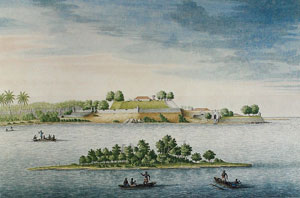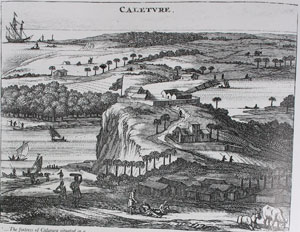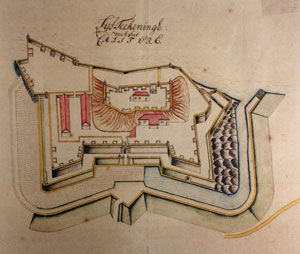After the British ousted the Dutch from Ceylon in 1796, the first comprehensive account of the island in English was written by a soldier, Captain Robert Percival of His Majesty’s 19th Foot Regiment, and titled An Account of the Island of Ceylon (1803). (Robert Knox, in his pioneering 1681 account An Historical Relation of Ceylon was unable to accomplish such wide inspection of the island.) Percival’s description of the coastal road south from Colombo to Kalutara - or rather Caltura as the British would have it – is an enchanting one.
For those jaded Galle Road travellers who experience only the glare of the sun (apart from the nightmarish traffic and insane behaviour of drivers) on the journey south, Percival makes a startling disclosure. “From Pantura (Panadura) to Caltura,” he writes, “a distance of 10 miles, the whole country may be considered as one delightful grove; and the road has entirely the appearance of a broad walk through a shady garden. Few spaces of it are so much exposed as to allow even the hottest sun at noon-day to penetrate it. The grateful refreshment such a road affords to a traveller in this sultry climate, can only be conceived by those who have passed from Colombo to Caltura.
 |
| ‘The fortress of Kalutara from the river side’---
Watercolour C. Steiger, c. 1710, Rijiksmuseum, Amsterdam |
Percival continues: “The goodness of the roads here is remarkable; and the vigour communicated by the coolness of the shade, is very sensibly felt by a European.” It is quite remarkable how many 19th-century visitors expressed admiration of the condition of Galle Road as it is now known. For example, industrialist Andrew Carnegie writes in Round the World (1884): “The drive of 60 miles to the railway which extends to Colombo is one of the best treats we have yet had. The road is equal to one of our best park avenues, as indeed are all the roads we saw in Ceylon.”
The coolness of the air is augmented in Kalutara by sea breezes from the south-west, which meant that the place became one of Ceylon’s major sanitariums. Indeed, as James Emerson Tennent, Colonial Secretary and author of the classic Ceylon (1859) expresses it: “The freshness of its position, combined with the beauty and grandeur of the surrounding scenery, rendered it the favourite resort of the Dutch and afterward the British.” While Kalutara was considered the best low-country sanitarium, it was Nuwara Eliya that provided the main sanitarium from the 1830s.
“The river at Caltura is here about a mile broad,” Percival wrote of the Kalu Ganga. “It washes two sides of the fort by which it is commanded, and is navigable by boats to the sea.”
Tennent mentions another way of approaching Kalutara - the descent of the Kalu Ganga from Ratnapura, “effected with great ease in the boats which bring down rice and arecanuts to the coast. Along the banks, the yellow stemmed bamboo waves its feathery leaves, and on approaching the sea the screw pines and mangroves grow in dense clusters, and over-arch the margin of the stream.”
J.W. Bennett, a disgruntled civil servant, nevertheless wrote a fine book, Ceylon and its Capabilities (1843). Kalutara could, of course, be reached by travelling north on Galle Road, as well as south. On this route Bennett encountered several miles from Kalutara an extremely rare “double coconut-tree, the heads of which branch off at about 60 feet from the ground like the letter Y [that] is considered by the superstitious natives an omen of great good fortune to the family to whom it may belong”.
The fort mentioned by Percival was originally built by the Portuguese early in the 17th century at the expense of desecrating the ancient Gangatilaka Vihare. The Dutch formed a truce with the Portuguese, but with its termination the fort was abandoned in 1642 and the Dutch seized it, only to mysteriously evacuate it the following year. So the Portuguese took possession until 1655, when the Dutch launched a victorious seaborne invasion.
 |
| The engraving from Baldaeus, 1672, attempts to give an impression of the old Portguese fort |
The Hollanders raised a strong surrounding wall, and strengthened the defences with a moat, ditches and a drawbridge. In addition, a proper road was constructed to connect Kalutara with Colombo. The fort was surrendered to the British in 1796, and was garrisoned until shortly after the capitulation of the Kandyan kingdom in 1815, when it fell into disuse.
“Westward [of Kalutara] the river empties itself into the ocean, amidst rocks and grooves, where the fishermen shelter their boats and build their huts,” the traveller and artist Maria Graham remarks in Journal of a Residence in India (1812). (Notably, she was the first female to describe the island in English.) “As I was attempting to sketch the scene,” she writes, “a violent storm of rain, thunder, and lightning came on, with all the grand circumstances peculiar to tropical climates, and forced us to take shelter in the rest-house.”
The crossing of the broad river next morning provided the opportunity for a demonstration of colonial excess: “First our palanquins and servants went over in three small boats lashed together, and with them a number of people carrying lights; then all the village musicians in separate boats; and lastly our boat, dressed with white cotton, flowers, and illuminated with the dried coco-nut leaves. I really never saw so gay a scene; and it was with no small regret that I reached the opposite shore, to shut myself up in my palanquin, and to listen to the monotonous song of my palanquin-bearers.”
“From the great plenty of game about Caltura, frequent shooting parties resort to it, and the commander’s hospitality is often called forth,” Percival comments regarding the hunting of deer and wild hog. “Occasional passengers also find good accommodation provided for them, as government has furnished the commanding officer with an excellent house, and also gives him a monthly allowance for keeping open table.” Those were the days . . .
“Certain native manufactures are carried on to a considerable extent around Caltura,” Percival remarks, and then reveals the extraordinarily diverse commerce of the area. “A great quantity of arrack in particular is made from the groves of cocoa-trees, which extend several miles in every direction.
There is also a large plantation of sugar canes [such cultivation didn’t succeed due to excessive iron in the soil], and a distillery of rum carried out by some Dutchmen, who reside in the village and neighbourhood. It is however very much inferior in quality to the West Indian rum.”
 |
| Bird’s-eye view, ground plan of the fort-- Watercolour, Rumpf’s diary,
1717-21, ARA, The Hague |
Tennent draws attention to creatures inebriated not by the rum but by toddy. “The trees, during the process of drawing the toddy, are frequented by great bats called by the Europeans ‘flying foxes’ [common flying fox, Pteropus giganteus, ‘maha-wawula’]. They are attracted in numbers by the fermenting juice, and drink from the earthen chalices which are suspended to collect it. A friend of mine had his attention frequently drawn to the unusual noises by the revels of these creatures. It assumed at the beginning to be an ordinary quarrel, but grew by degrees to become manifestly a drunken riot.”
There were horticultural possibilities too. Percival states: “Some tracts of cinnamon are scattered up and down here.” Bennett gives a more thorough account: “Coffee, of a very superior kind, is grown in this district; and I know of no place better calculated, from its shade and moisture, for growing Caoutchouc [pronounced kou ch k , French for “rubber”]. For cotton the soil is admirably well adapted, as well as for the cultivation of the chocolate nut.”
To finish, let me relate a pioneering experiment conducted by Bennett, which demonstrated that the belief that scorpions are suicidal was a misconception. “From experiments that I made at Kalutara, to ascertain how far the vulgar opinion, that the scorpion, when surrounded by fire, would destroy itself, was well founded or otherwise, I can vouch from the results that it is groundless, as far as six distinct experiments with scorpions may be considered a fair trial.
The insects ran about in a state of the greatest irritation, and one was singed by attempting to cross the burning charcoal; but with this the mischief ended, and the rest were unanimously acquitted of all disposition towards suicidal monomania.”
Scorpions: Taking sting out of myth
“The story that scorpions commit suicide by stinging themselves, when surrounded by a ring of fire, is based on misinterpretation of their behaviour. What happens when a scorpion is subjected to heat is simply this: first it tries to escape and failing in this, begins to strike frantically with its tail as if in an attempt to sting. Finally it becomes insensitive, overcome by heat, and dies.” – Encyclopedia Britannica |




